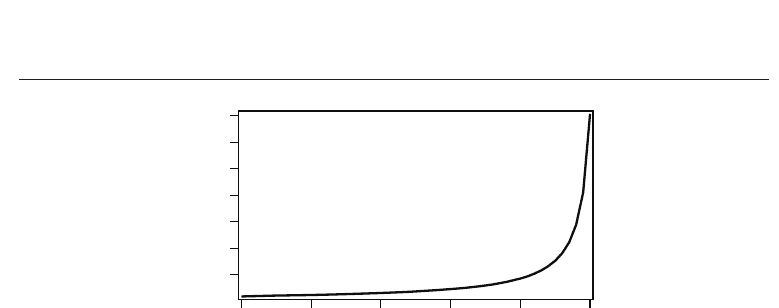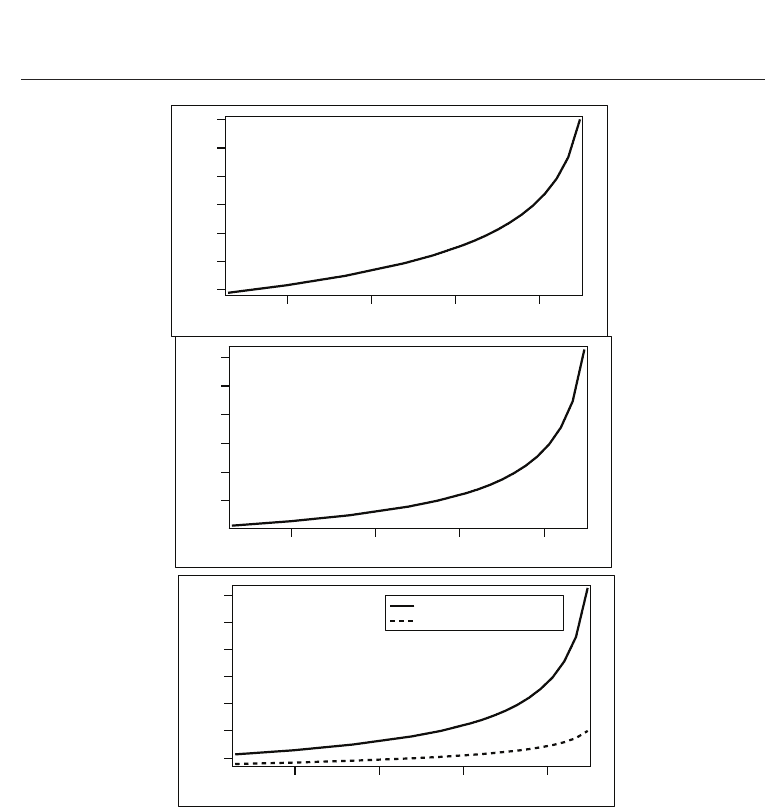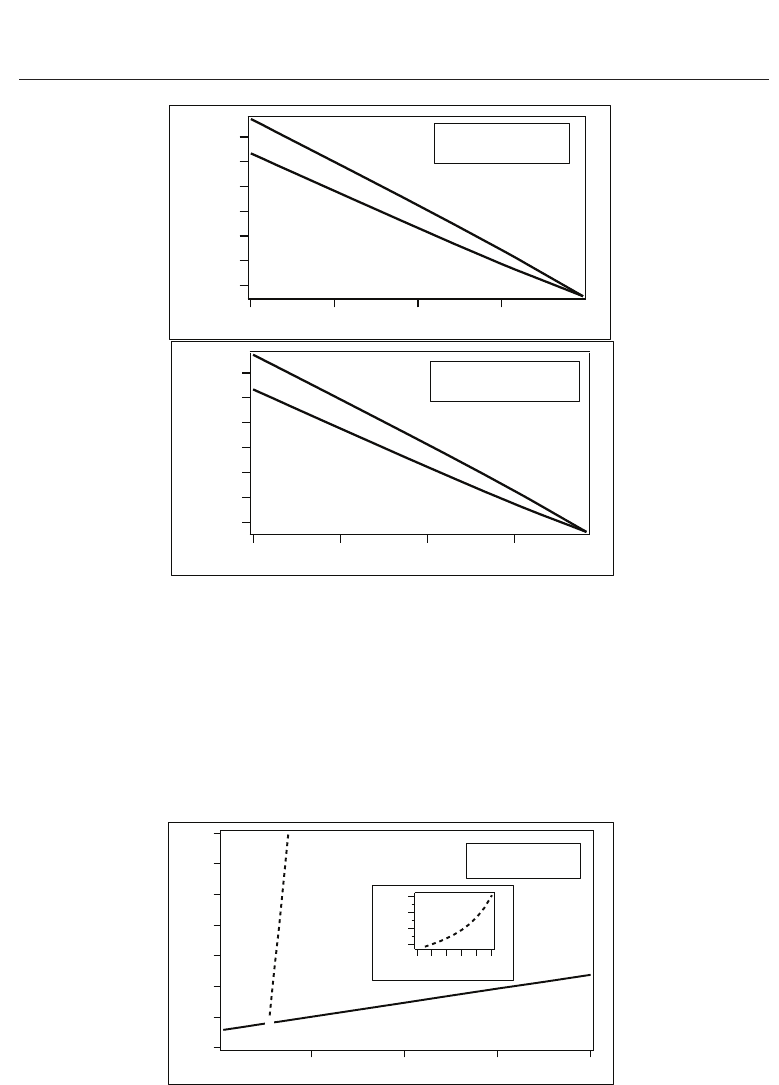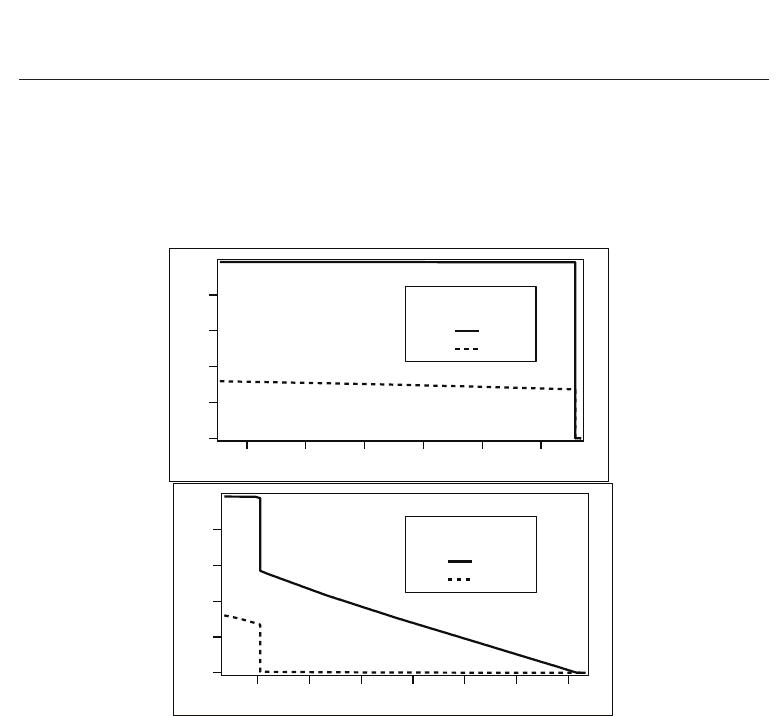Marulanda J.M. (ed.) Electronic Properties of Carbon Nanotubes
Подождите немного. Документ загружается.


0
Liquid Crystal - Anisotropic
Nanopar ticles Mixtures
Vlad Popa-Nita
1
, Matej Cvetko
2
and Samo Kralj
3
1
Faculty of Physics, University of Bucharest
2
Regional Development Agency Mura, Murska Sobota
3
Faculty of Natural Science and Mathemetics, University of Maribor
1
Romania
2,3
Slovenia
1. Introduction
Carbon nanotubes (Iijima, 1991) are one of the most interesting new materials which emerges
during the last twenty years. They either consist of a single sheet of carbon atoms covalently
bonded in hexagonal arrays rolled up into a cylinder with a diameter of about one nanometer
(single-walled nanotubes - SWNTs), or are built up of multiple carbon sheets producing rods
with diameters ranging from a few to tens or even hundreds of nanometer (multi-walled
nanotubes - MWNTs). The aspect ratio of these objects can vary from hundred to many
thousands.
Most of CNTs extraordinary properties of potential use in various applications could be
realized in relatively well aligned samples. One method of alignment consists in dispersing
the CNTs into a nematic phase of a LC (either thermotropic or lyotropic). For recent reviews
see e.g., (Lagerwall & Scalia, 2008; Rahman & Lee, 2009; Zakri, 2007; Zhang & Kumar, 2008).
Theoretically, equilibrium orientation of a single elongated particle immersed in a nematic
LC phase is rather well explored (Andrienko et al., 2002; 2003; Brochard & de Gennes,
1970; Burylov & Raikher, 1990; 1994; Hung et. al., 2006). Continuum theory predicts
alignment of the particle’s longer axis along the nematic director
−→
n for different types
of boundary conditions in the strong anchoring limit case (Brochard & de Gennes, 1970;
Burylov & Raikher, 1990; 1994). On the contrary, in the weak anchoring limit the particle
may orient either along or perpendicular to the nematic director depending on the boundary
conditions (Burylov & Raikher, 1990).
The collective behavior of CNTs dispersed in isotropic solvents or in LC is theoretically
relatively weakly explored. Due to their structure and behavior, the CNTs can be consider
essentially as rigid-rod polymers with a large aspect ratio (Green et. al., 2009). The steric
theory for the electrostatic repulsion of long rigid rods has been used to investigate the SWNT
phase behavior in their suspensions (Sabba & Thomas, 2004). Calculations have shown that
SWNTs in a good solvent is analogous to the classic rigid-rod system if the van der Waals
force between CNTs is overcome by strong repulsive interrods potentials. When the solvent
is not good, the van der Waals attractive interactions between the rods are still strong and as
a result, only extremely dilute solutions of SWNTs are thermodynamically stable and no LC
29

2 Will-be-set-by-IN-TECH
phases form at room temperature. The liquid crystallinity of CNTs with and without van der
Waals interactions has been analyzed by using the density functional theory (Somoza & Sagui,
2001). In the presence of van der Waals interaction, the nematic as well as the columnar
phases occur in the temperature-packing fraction phase diagram in a wide range of very
high temperatures. In the absence of van der Waals interaction the system is dominated only
by steric repulsive interactions. With an increase of packing fraction, the system undergoes
an isotropic-nematic phase transition via a biphasic region. The isotropic-nematic packing
fraction decreases with the increase of the aspect ratio of CNTs. The phase behavior of rodlike
particles with polydisperse length and solvent-mediated attraction and repulsion is described
by an extension of the Onsager theory for rigid rods (Green et. al., 2009). The main conclusion
of these theoretical models is that to obtain liquid crystal phases of CNTs at room temperature
the strong van der Waals interaction between them must be screened out. This requires a good
solvent with an ability to disperse CNTs down to the level of individual tube.
In two recent papers (van der Schoot et. al., 2008; Popa-Nita & Kralj, 2010), two of us
presented a phenomenological theory for predicting the alignment of CNTs dispersions in
thermotropic nematic LC in the two limits of the anchoring of LC molecules at the CNT
surface. We combined the Landau-de Gennes free energy for thermotropic ordering of the
LC solvent and the Doi free energy for the lyotropic nematic ordering of CNTs caused by
excluded-volume interactions between them. We have analyzed the phase ordering of the
binary mixture as a function of the volume fraction of CNTs, the strength of the coupling and
the temperature.
However, coupling between LC molecules and nanoparticles (NPs) of regular geometry could
in some circumstances give rise to disordered structures with pronounced memory effects.
Namely, LC orientational ordering is extremely sensitive to perturbations due to its soft
character (de Gennes & Prost, 1993). For example, if a LC is quenched from an isotropic into
a nematic phase a continuous symmetry breaking takes place (Imry & Ma, 1975; Kralj et al.,
2008; Zurek, 1996). In the isotropic phase all directions are equivalent while in the nematic
phase a preferred orientation is singled out locally. Because of finite speed of information
propagation well separated regions are causally disconnected. For this reason a domain-type
in orientational ordering is inevitable formed. A domain pattern is well characterized by a
single characteristic domain size ξ
d
. In pure LC the domain size grows with time obeying
the scaling law ξ
d
∝ t
γ
,whereγ = 0.5 in a bulk sample (Bradac et al., 2002). The sample
gradually evolves into a homogeneously aligned sample in order to reduce relative expensive
domain wall penalties. In a liquid crystal- NP mixture, the NPs could act as pinning centers
and consequently domain pattern could be stabilized (Kralj et al., 2008). Therefore, in certain
conditions NPs could introduce disorder into a system.
In the present paper we study both ordering and disordering phenomena in a LC-NP mixture.
In the first part of the present paper we focus on LC induced ordering of CNT. We present
comparatively the results of our phenomenological model in the two limiting cases: i) the
weak anchoring limit where the interaction between CNTs and LC molecules is thought to
be sufficiently weak not to cause any director field deformations in the nematic host fluid
and ii) the strong (rigid) anchoring limit where the CNT causes the nematic director field
distortions generating topological singularities. In the second part we study conditions where
orientational ordering of a NP-LC mixture could be essentially short ranged.
The plan of the paper is as follows. In Sec. 2 we study LC driven orientational ordering
of CNTs. In Subsection 2.1 our phenomenological model is introduced. In Sec. 2.2 we
analyze ordering of CNT in the isotropic LC phase. The trictitical behavior is analyzed in
646
Electronic Properties of Carbon Nanotubes

Liquid Crystal - Anisotropic
Nanoparticles Mixtures 3
detail in Sec. 2.3. Possibility of homogeneous alignment of CNTs in investigated in Sec.
2.4. Both weak and strong anchoring LC-CNT interactions are taken into account. In Sec.
3 possible disordering effects in LC-NP mixtures are analyzed using a simple lattice-type
semimicroscopic description. The semimicroscopic model is described in Sec. 3.1 and the
corresponding simulation method in Sec. 3.2. The NPs induced domain type stabilization of
LC ordering is demonstrated in Sec. 3.3. In the last section we summarize our conclusions.
2. LC induced CNT ordering
We first discuss conditions under which LC orientational ordering could be used in order to
align immersed anisotropic NPs. We confine our interest to CNTs due to their importance in
various applications. The ordering of LC-CNT mixtures is treated using a mean field type
phenomenological model.
2.1 Free energy
The free energy per unit volume of the CNTs-LC binary mixture consists of four contributions
f
= f
mix
+ f
CNT
+ f
LC
+ f
C
.(1)
The first term in Eq. (1) is the free energy density of isotropic mixing of CNTs and LC that in
the framework of Flory lattice theory is given by (Flory, 1953)
f
mix
/k
B
T = υ
−1
CNT
Φ ln Φ + υ
−1
LC
(1 − Φ) ln(1 − Φ)+υ
−1
0
χΦ(1 − Φ),(2)
where k
B
is the Boltzmann constant, T is the absolute temperature, Φ is the volume fraction
of CNT, 1
−Φ is the volume fraction of LC, and χ ≡ U
0
/k
B
T is the Flory-Huggins interaction
parameter related to the isotropic interaction between CNT and LC (Flory, 1953). In the
following, we assume χ
> 0 (positive free energy of mixing), this being the most usual case,
at least when van der Waals interactions are dominant. Here υ
CNT
≈
π
4
LD
2
approximates
volume occupied by a carbon nanotube of length L and diameter D.ThevolumeofaLC
molecule of length l and diameter d is given by υ
LC
≈
π
4
ld
2
. In the following we consider that
the volume of a LC molecule is equal to the volume of a cell in the Flory lattice (Flory, 1953)
(υ
LC
= υ
0
). The first two terms in Eq. (2) represent the entropy of isotropic mixing of LC and
CNT components neglecting their orientational degree of ordering.
The free energy density representative of the excluded volume effects responsible for the first
order nematic-isotropic transition of CNT is expressed as (Doi & Edwards, 1989)
f
CNT
/k
B
T =
Φ
υ
CNT
1
2
1
−
u
3
S
2
CNT
−
u
9
S
3
CNT
+
u
6
S
4
CNT
.(3)
The parameter u is related to the volume fraction of CNT by the relation u
= ΦL/D.The
model neglects the van der Waals attractions between CNTs which are responsible for their
tendency to form bundles. The degree of orientational ordering of CNT is given by the order
parameter S
CNT
. Perfectly aligned CNT correspond to S
CNT
= 1, and isotropic ordering
is signaled by S
CNT
= 0. On increasing Φ this term enforces the first order orientational
phase transition of CNT from the isotropic phase of CNT with S
CNT
= 0, to the nematic
phase of CNT phase with S
CNT
=(1 +
√
9 −24/u)/4. The first order nematic-isotropic phase
transition takes place at u
= u
NI
= 27/10 and S
CNT
(u
NI
)=1/3. The limits of stability of
nematic and isotropic phases are given by u
+
= 8/3 (S
+
CNT
= 1/4) and u
∗
= 3 (S
∗
CNT
= 1/2).
647
Liquid Crystal - Anisotropic Nanoparticles Mixtures

4 Will-be-set-by-IN-TECH
For the thermotropic uniaxial nematic LC component we use the standard Landau-de Gennes
(de Gennes & Prost, 1993) free energy density in terms of the nematic order parameter S
LC
f
LC
=(1 − Φ)
3
2
a
(T − T
∗
)S
2
LC
−
3
4
BS
3
LC
+
9
4
CS
4
LC
,(4)
where
(
1 −Φ
)
accounts for the part of the volume not taken up by LC. The quantities T
∗
(the
undercooling limit temperature of the isotropic phase of the pure liquid crystal), a, B,andC are
material-dependent constants. This free energy density enforces the weakly first order phase
transition from the isotropic phase to the nematic phase of LC. At T
= T
NI
= T
∗
+ B
2
/(24aC),
the two phases of LC, nematic (S
nem 0
= B/6C)andisotropic(S
iso
= 0) coexist in equilibrium.
The detailed derivation of the coupling free energy density term f
C
in the two limiting regimes
has been presented previously (van der Schoot et. al., 2008; Popa-Nita & Kralj, 2010). Here we
give only the final expressions. The two regimes can be defined by the relation between the
radius of the particle R and the surface extrapolation length d
e
= K/W,whereK is the Frank
elastic constant and W is the anchoring energy.
i) the weak anchoring limit (R
<< d
e
)- the anchoring is not able to produce large
deformations in the surrounding nematic matrix. In this limit the coupling free energy density
writes as (van der Schoot et. al., 2008)
f
C
= −γ
w
Φ(1 − Φ)S
LC
S
CNT
1
−
1
2
S
CNT
,(5)
where the coupling constant is given by γ
w
= 4W/6 R. Depending on the value of R and
considering a typical value of anchoring energy of 10
−6
N/m, the coupling constant of the
weak anchoring regime can range between 10
−3
−10
3
N/m
2
.
ii) strong anchoring limit (R
>> d
e
) - the anchoring is rigid and gives rise to topological
singularities of the nematic director which cause strong interaction between the dispersed
nanotubes. In this limit the coupling free energy density writes as (Popa-Nita & Kralj, 2010)
f
C
= −γ
s
Φ(1 −Φ) S
2
LC
S
CNT
1
−
1
2
S
CNT
,(6)
where the coupling constant is given by γ
s
= 2K/3 R
2
. Depending on the value of R and
considering a typical value of elastic constant of 10
−11
N the coupling constant of the strong
anchoring regime can range between 10
3
−10
7
N/m
2
.
Using Eqs. (2), (3), (4), (5), and (6), the total phenomenological free energy density in the weak
anchoring limit becomes:
f
= k
B
T
υ
−1
CNT
Φ ln Φ + υ
−1
LC
(1 −Φ) ln(1 − Φ)+υ
−1
LC
χΦ(1 − Φ)
+
k
B
TΦ
υ
CNT
1
2
1
−
u
3
S
2
CNT
−
u
9
S
3
CNT
+
u
6
S
4
CNT
+(1 −Φ)
3
2
a
(T − T
∗
)S
2
LC
−
3
4
BS
3
LC
+
9
4
CS
4
LC
−γ
w
Φ(1 −Φ) S
LC
S
CNT
1
−
1
2
S
CNT
,(7)
while in the strong anchoring limit, only the last term differ:
648
Electronic Properties of Carbon Nanotubes

Liquid Crystal - Anisotropic
Nanoparticles Mixtures 5
f = k
B
T
υ
−1
CNT
Φ ln Φ + υ
−1
LC
(1 −Φ) ln(1 − Φ)+υ
−1
LC
χΦ(1 − Φ)
+
k
B
TΦ
υ
CNT
1
2
1
−
u
3
S
2
CNT
−
u
9
S
3
CNT
+
u
6
S
4
CNT
+(1 −Φ)
3
2
a
(T − T
∗
)S
2
LC
−
3
4
BS
3
LC
+
9
4
CS
4
LC
−γ
s
Φ(1 −Φ) S
2
LC
S
CNT
1
−
1
2
S
CNT
.(8)
In calculations we consider a regime determined by the following geometrical and material
parameters. We limit to CNT of characteristic dimensions L
≈ 400 nm and R ≈ 1nm. For
LC molecules we set L
≈ 3nmandR ≈ 0.25 nm, corresponding to a typical nematogen. For
LC material constants we chose as representative pentylcyanobiphenyl (5CB) LC, for which
T
∗
= 306 K, a ≈ 3.5 ·10
4
J ·m
−3
·K
−1
, B ≈ 7.1 ·10
5
J ·m
−3
, C ≈ 4.3 · 10
5
J ·m
−3
, K ∼ 10
−11
N (Oswald & Pieranski, 2005). This choice yields S
nem 0
≈ 0.28 and T
NI
= T
∗
+ B
2
/24aC ≈
307.5 K.
Using this phenomenological form of the free energy, in the following sections we present the
phase behavior of the binary mixture of CNTs and LC as a function of temperature, volume
fraction and the coupling strength.
2.2 Dispersion of CNTs in the isotropic phase of LC
In this case, S
LC
= 0, the coupling free energy densities (5) and (6) cancel and the free energy
density becomes
f /k
B
T = υ
−1
CNT
Φ ln Φ + υ
−1
LC
(1 − Φ) ln(1 − Φ)+υ
−1
LC
χΦ(1 − Φ )
+
Φ
υ
CNT
1
2
1
−
u
3
S
2
CNT
−
u
9
S
3
CNT
+
u
6
S
4
CNT
.(9)
The equilibrium between the isotropic ( S
CNT
= 0) and the nematic phase (S
CNT
> 0) of
CNTs is determined by equating the chemical potentials of CNTs (μ
CNT
= υ
CNT
[ f +(1 −
φ)∂ f /∂φ])andLC(μ
LC
= υ
LC
( f −φ∂ f /∂φ)) in the two phases. The value of S
CNT
is obtained
by minimizing the free energy with respect to S
CNT
.
In the absence of the isotropic interaction term (χ
= 0), for our set of geometric parameters the
nematic-isotropic coexistence is determined by the following values of parameters: (Φ
iso
=
0.013487, S
CNT
= 0) and (Φ
nem
= 0.013513, S
CNT
= 0.3365) and correspondingly the relative
variation of volume fraction of CNTs at the transition (the Flory chimney) is about 0.19%. The
phase gap in this condition is very narrow indeed less than the 1% predicted by Onsager and
Flory for monodisperse lyotropic LC. On the basis of the polarized light microscopy, Song
and Windle (Song & Windle, 2005) have estimated a biphasic range between 1% and 4% in
an aqueous dispersion of MWNTS. This comparatively large range of the biphasic region is
plausibly caused by the polidispersity in terms of length, diameter, and straightness of the
nanotubes as well as the possibility of segregation of the more nematogenic tubes.
In Figure 1, we have plotted the relative variation of the volume fraction of the CNTs at the
nematic-isotropic phase transition as a function of the isotropic interaction parameter χ.
649
Liquid Crystal - Anisotropic Nanoparticles Mixtures

6 Will-be-set-by-IN-TECH
70x10
-3
60
50
40
30
20
10
ΔΦ/Φ
iso
0.50.40.30.20.10.0
χ
Fig. 1. The relative variation of the volume fraction of CNTs at the nematic-isotropic phase
transition in the isotropic phase of LC.
Because the isotropic interaction parameter is proportional with reciprocal temperature (here
we did not consider this dependence), the volume fraction gap at the transition increases
with lowering the temperature; the poor solvent for CNTs becomes poorer lowering the
temperature. For values of χ larger than
≈ 0.4 the relative variation of the volume fraction at
the transition increases considerably with the value of χ. The predicted value of ΔΦ/Φ
iso
=
1% is obtained for χ = 0.42.
2.3 Tricritical point
The free energy density is given now by the general forms (7) and (8), respectively.
For very small values of the coupling parameter γ
w
(or equivalently γ
s
), the nematic-isotropic
phase transition of the CNTs is first order and the order parameter jumps at the transition
from zero to some non-zero value depending on the value of the coupling parameter. With
increasing the interaction parameter, the transition becomes continuous at a tricritical value
γ
w,t
(or equivalently γ
s,t
). The tricritical point where the discontinuous phase transition
becomes continuous is obtained by solving the equations ∂
2
f /∂S
2
LC
= ∂
3
f /∂S
3
LC
= 0. They
yield at the tricritical point universal values for the order parameter S
(t)
CNT
= 1/6 and volume
fraction Φ
t
= 0.01296. The tricritical values of the coupling parameter γ
t
as a function of
temperature are presented in Figure 2.
With decreasing the temperature, as S
LC
increases, the external field felt by the CNTs increases
and the nematic-isotropic phase transition of CNTs becomes continuous for increasingly lower
values of interaction parameter. Our estimates of the coupling constant suggest that for typical
value of parameters, γ
>> γ
t
for both limiting cases, meaning that in the nematic phase of
LC, the nematic-isotropic phase transition of CNTs becomes a continuous transition.
To illustrate how in the limit of low values of coupling parameter the isotropic-nematic phase
transition of the CNTs is affected by the nematic host fluid, the phase diagram of the coexisting
volume fractions as a function of the coupling parameter is plotted in Figure 3 for both limiting
regimes. The binodals are drawn at the undercooling limit temperature of the isotropic phase
( T
∗
= 307.56K).
In both limiting regimes, the gaps of the volume fractions decrease with increasing the
coupling constant and becomes zero for γ
w
= γ
w,t
= 79.6 N/m
2
(for weak anchoring) and for
γ
s
= γ
s,t
= 191 N/m
2
for strong anchoring case, respectively. The isotropic-nematic phase
transition of CNTs takes place at lower volume fraction with increasing the coupling constant.
650
Electronic Properties of Carbon Nanotubes

Liquid Crystal - Anisotropic
Nanoparticles Mixtures 7
100
90
80
70
60
50
40
γ
w,t
(N/m
2
)
308306304302
T,K
Continuous transition
Discontinuous transition
a)
350
300
250
200
150
100
50
γ
t
(N/m
2
)
308306304302
T,K
STRONG ANCHORING
WEAK ANCHORING
c)
350
300
250
200
150
100
γ
s,t
(N/m
2
)
308306304302
T,K
Continuous transition
Discontinuous transition
b)
Fig. 2. The tricritical values of the coupling parameter γ
t
as function of temperature. The
weak anchoring limit case is represented in F ig. 2a. In Fig. 2b is shown the strong anchoring
limit case, while in Fig. 2c the both regimes are represented.
2.4 Homogeneous mixture
One of the most challenging task for realizing the applications in optoelectronics is to
homogeneously disperse the CNTs into the nematic host, as CNTs have a tendency to
aggregate into networks and fibrils (MWNTs) within the dispersion due to the van der Waals
interactions between the nanotubes. The three different standard approaches to obtain the
homogeneous dispersion are reviewed in (Lagerwall & Scalia, 2008; Rahman & Lee, 2009).
To calculate the phase diagram of a homogeneous mixture, we use the free energy density
given by Eq. (7) (for the weak anchoring case) and the same quantity given by Eq. (8)
(corresponding to the strong anchoring case) with a constant volume fraction Φ of the CNTs.
The equilibrium values of the order parameters S
CNT
and S
LC
are obtained by minimizing
651
Liquid Crystal - Anisotropic Nanoparticles Mixtures

8 Will-be-set-by-IN-TECH
13.5x10
-3
13.4
13.3
13.2
13.1
13.0
12.9
Φ
6040200
γ
w
(N/m
2
)
ISOTROPIC
PHASE OF CNTs
NEMATIC
PHASE OF CNTs
WEAK ANCHORING
T
*
=307.56K
a)
13.5x10
-3
13.4
13.3
13.2
13.1
13.0
12.9
Φ
150100500
γ
s
(N/m
2
)
NEMATIC
PHASE OF CNTs
ISOTROPIC
PHASE OF CNTs
STRONG ANCHORING
T
*
=307.56K
b)
Fig. 3. Phase diagram of CNTs in the nematic host fluid. Indicated are the coexisting volume
fractions in the isotropic and nematic phases discussed in the main text. The weak anchoring
case is shown in Fig. 3a, while Fig. 3b presents the strong anchoring case.
the free energy density (∂ f /∂S
CNT
= ∂ f /∂S
LC
= 0). The corresponding phase diagrams are
plotted and discussed in the next two sections.
2.4.1 Weak anchoring case
The phase diagram ( Φ, T) in the weak anchoring regime for a typical value of the coupling
constant γ
= 6.6 ·10
5
N/m
2
is plotted in Fig. 4.
309.6
309.5
309.4
309.3
309.2
309.1
309.0
308.9
T,K
8x10
-3
642
Φ
isotropic
paranematic
nematic
WEAK ANCHORING
γ
=6.6*10
5
N/m
2
O
TP
340
330
320
310
T,K
10x10
-3
6420
Φ
Fig. 4. The (Φ, T) phase diagram of a homogeneous mixture in the weak anchoring limiting
case.
652
Electronic Properties of Carbon Nanotubes

Liquid Crystal - Anisotropic
Nanoparticles Mixtures 9
Three different regions are to be distinguished. The isotropic region corresponds to a
total absence of the orientational order (both components are in the isotropic phase), the
paranematic region is characterized by a very small degree of the orientational order of
both components, while in the nematic region both components possess a relatively large
degree of orientational order. The dashed line defines a second order (the order parameter
is continuous at the transition, while its derivative with respect to temperature has a jump)
isotropic-paranematic phase transition (inside the figure we have shown this line for larger
values of the temperature). The first segment (Φ
≤ 0.00108) of the continuous line corresponds
to first order (the order parameter has a jump at the transition) nematic-isotropic phase
transition of both components. The second segment (Φ
≥ 0.00108) corresponds to the first
order nematic-paranematic phase transition of the both components. The circle defines the
triple point of the system that has the coordinates Φ
t
= 0.00108 and T = 308.98 K. The
increase of nematic-isotropic phase transition temperature (shown by the continuous line in
Fig. 4) is experimentally verifiably (Duran et. al., 2005; Lebovka et. al., 2008) and could be
explained by the fact that CNTs act as heterogeneous nucleation agents for LC.
To see in more detail the characteristics of these phase transitions we have plotted in Figure 5
the order parameters profiles as a function of volume fraction of CNTs for two different values
of the temperature.
0.9
0.8
0.7
0.6
0.5
0.4
S
CNT
,S
LC
10x10
-3
8642
Φ
WEAK ANCHORING
T=308.68K
S
CNT
S
LC
a)
0.8
0.6
0.4
0.2
0.0
S
CNT
,S
LC
10x10
-3
8642
Φ
WEAK ANCHORING
T=309.16K
S
CNT
S
LC
b)
Fig. 5. The order parameters profiles of CNTs (continuous line) and LC (dotted line) for
γ
= 6.6 ·10
5
N/m
2
and for two different values of the temperature.
In Figure 5a, the order parameters profiles are shown for T
= 308.68 K, value that belongs
to the nematic region in Fig. 4. There is no phase transition for this value of temperature
and as consequence the order parameters are continuous and CNTs are almost perfectly
aligned (S
CNT
≈ 1) for all values of volume fraction (see the continuous line). On the
653
Liquid Crystal - Anisotropic Nanoparticles Mixtures

10 Will-be-set-by-IN-TECH
contrary, the value of temperature in Figure 5b ( T = 309.16 K) corresponds to a second order
isotropic-paranematic phase transition at a small value of the volume fraction and to a first
order paranematic-nematic phase transition at a larger value of the volume fraction. In this
case, the CNTs are strongly aligned at relatively large value of the volume fraction.
In Figure 6, we have shown the order parameters profiles as a function of temperature for two
different values of the volume fraction of CNTs.
0.8
0.6
0.4
0.2
0.0
S
CNT
,S
LC
308.95308.90308.85308.80308.75308.70
T,K
WEAK ANCHORING
Φ
=1*10
-3
S
CNT
S
LC
a)
0.8
0.6
0.4
0.2
0.0
S
CNT
,S
LC
312.0311.5311.0310.5310.0309.5309.0
T,K
WEAK ANCHORING
Φ
=3*10
-3
S
CNT
S
LC
b)
Fig. 6. The order parameters profiles of CNTs (continuous line) and LC (dotted line) for
γ
= 6.6 ·10
5
N/m
2
and two different values of the volume fraction.
In Figure 6a, the order parameter profiles are shown for a small value of the volume fraction
(Φ
= 1 · 10
−3
). For this value of the volume fraction, increasing the temperature the only
transition is the first order nematic-isotropic phase transition (see Figure 4) during which both
order parameters jump to zero. The larger value of the volume fraction of Figure 6b induces
two phase transitions (see Figure 4): a first order nematic-paranematic phase transition at
a lower value of the temperature during which both order parameters jump at lower values
and a second order paranematic-isotropic phase transition at a larger value of the temperature
during which both order parameters decrease continuously to zero.
2.4.2 Strong anchoring case
The corresponding phase diagram (Φ, T) for a typical value of the coupling constant γ =
6.6 · 10
5
N/m
2
is plotted in Fig. 7. Even if the corresponding phase diagram is similar to the
weak anchoring limiting case, there are some differences which we discuss in the following.
Also in this strong anchoring case, there are three different regions in the phase diagram. The
region I corresponds to a total absence of the orientational order (both components are in the
isotropic phase), region II corresponds to a nematic phase of CNT and an isotropic phase of
654
Electronic Properties of Carbon Nanotubes
